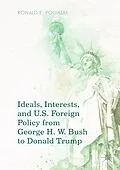This volume discusses the presidential foreign policies of the post-Cold War era, beginning with George H. W. Bush and ending with the first 17 months of Donald Trump's presidency. During this period, the United States emerged from the Cold War as the world's most powerful nation. Nevertheless, the presidents of this era faced a host of problems that tested their ability to successfully blend realism and idealism. Some were more successful than others.
Ronald Powaski is Adjunct Professor at Ashland University, USA, formerly teaching U.S. history at Cleveland State University. Among his published books are March to Armageddon: The United States, the Soviet Union, and the Nuclear Arms Race, The Cold War: The United States and the Soviet Union, and most recently, a two-volume study, American Presidential Statecraft.
Autorentext
Ronald Powaski is Adjunct Professor at Ashland University, USA, formerly teaching U.S. history at Cleveland State University. Among his published books are March to Armageddon: The United States, the Soviet Union, and the Nuclear Arms Race, The Cold War: The United States and the Soviet Union, and most recently, a two-volume study, American Presidential Statecraft.
Inhalt
Chapter 1. Prologue: Interests Versus Ideals
Chapter 2. Introduction
Chapter 3. The "Enlightened Realism" of George H.W. Bush, 1989-1993
Chapter 4. William Clinton: The Pragmatic Idealist, 1993-2001
Chapter 5. George W. Bush, Realism and Neoconservatism, 2001-2009
Chapter 6. Barack Obama, the Idealistic Realist, 2009-2017, Part I: The Middle East and East Asia
Chapter 7. Barack Obama, the Idealistic Realist, 2009-2017, Part II: Europe, Latin America, Africa, and Global Problems
Chapter 8. Donald Trump and "America First," 2017-
